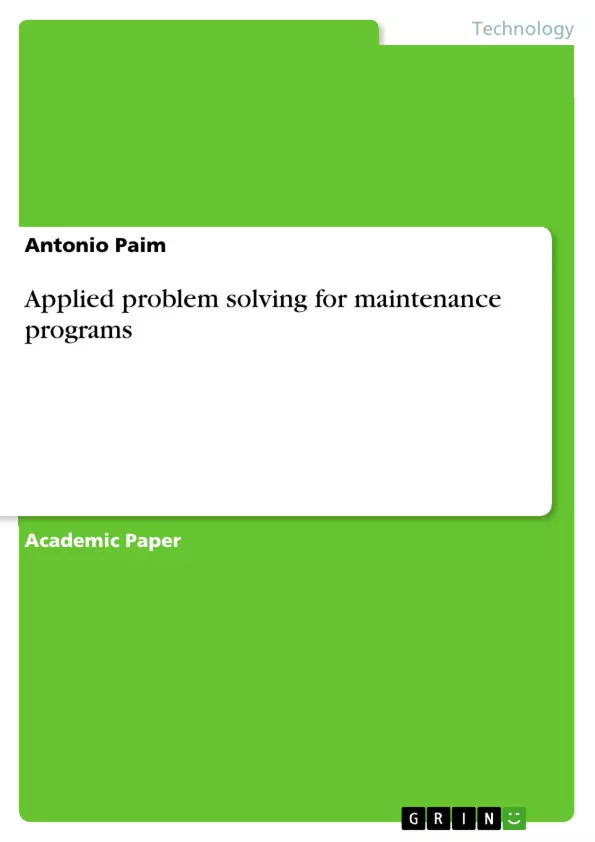The objective of this report is to present the issues related to successive equipment/machine failure within a Biorefinery industry in Angola. This work presents several complex problem-solving techniques that could be fully applied to the situation that enable the Planning and Control Maintenance (PC&M) department to interpret the information from large datasets from the machineries.
The combination of models and techniques allowed the team involved in the problem solving process to identify three preferred potential solutions related to equipment/machine failure. Through further analysis using the Plus/Minus/Interesting and Force Field Analysis it was possible to narrow these down to a single solution. The preferred solution was chosen by carrying out a comparative analysis and the weighted score indicated the suitability of the solution for the given scenario of the complex problem. Knowing that solution implementation is not readily accepted automatically, a PPA (Potential Problem Analysis) was presented in order to alleviate the risk of new problems occurring during the implementation of the chosen solution process. The implementation plan took into consideration the budget, the time and possible project cost escalation.
The recommendations that will be presented include stringent requirements for getting budget approval in order to expedite contractual agreements IoT (Internet of Things) providers, AI (Artificial Intelligence) companies and Outsource Expertise. It is suggested that if all of the requirements are met then the successive machine breakdown rate would achieve considerably low rates.
Inhaltsverzeichnis (Table of Contents)
- Problem Structuring
- Boundary Setting
- Recognition
- Interaction
- Conclusion and Recommendations
Zielsetzung und Themenschwerpunkte (Objectives and Key Themes)
This report analyzes the challenges faced by the Planning, Control and Maintenance (PC&M) department within a Biorefinery industry in Angola, specifically the issue of frequent equipment/machine failure. The report utilizes various problem-solving techniques to identify the root causes of this issue and propose a solution.
- Analyzing the complexity of data interpretation from equipment/machinery in a Biorefinery setting.
- Exploring the role of stakeholder interaction and collaboration in problem-solving.
- Identifying potential solutions through a structured problem-solving approach.
- Evaluating and selecting a preferred solution based on cost, time, and feasibility.
- Developing a comprehensive implementation plan to mitigate potential risks during solution deployment.
Zusammenfassung der Kapitel (Chapter Summaries)
The report begins by defining the problem of frequent equipment/machine failure in the Biorefinery industry. It examines the challenges faced by the PC&M department in interpreting large datasets from equipment/machinery. The report then outlines various problem-solving techniques including brainstorming models like Causal Mind Map and Cause-and-Effect Fishbone Diagram. It also explores the Why Analysis method to identify the boundaries of the problem and the solution space. The chapter further discusses the importance of stakeholder recognition and interaction in problem-solving.
The following chapter focuses on solution search and evaluation using techniques such as Morphological Analysis, Plus/Minus/Interesting, Castle, and Force Field Analysis. These techniques help to identify and evaluate potential solutions to address the equipment/machine failure issue. The report concludes with the selection of a preferred solution and presents a comprehensive implementation plan. This plan considers budget, time, and potential project cost escalation. The chapter also highlights recommendations for obtaining budget approval and contractual agreements with relevant stakeholders.
Schlüsselwörter (Keywords)
The primary keywords and focus topics of this report include problem-solving techniques, data interpretation, stakeholder collaboration, Biorefinery, equipment/machine failure, cause-and-effect analysis, solution evaluation, implementation planning, and potential problem analysis.
- Arbeit zitieren
- Antonio Paim (Autor:in), 2018, Applied problem solving for maintenance programs, München, GRIN Verlag, https://www.hausarbeiten.de/document/459876


